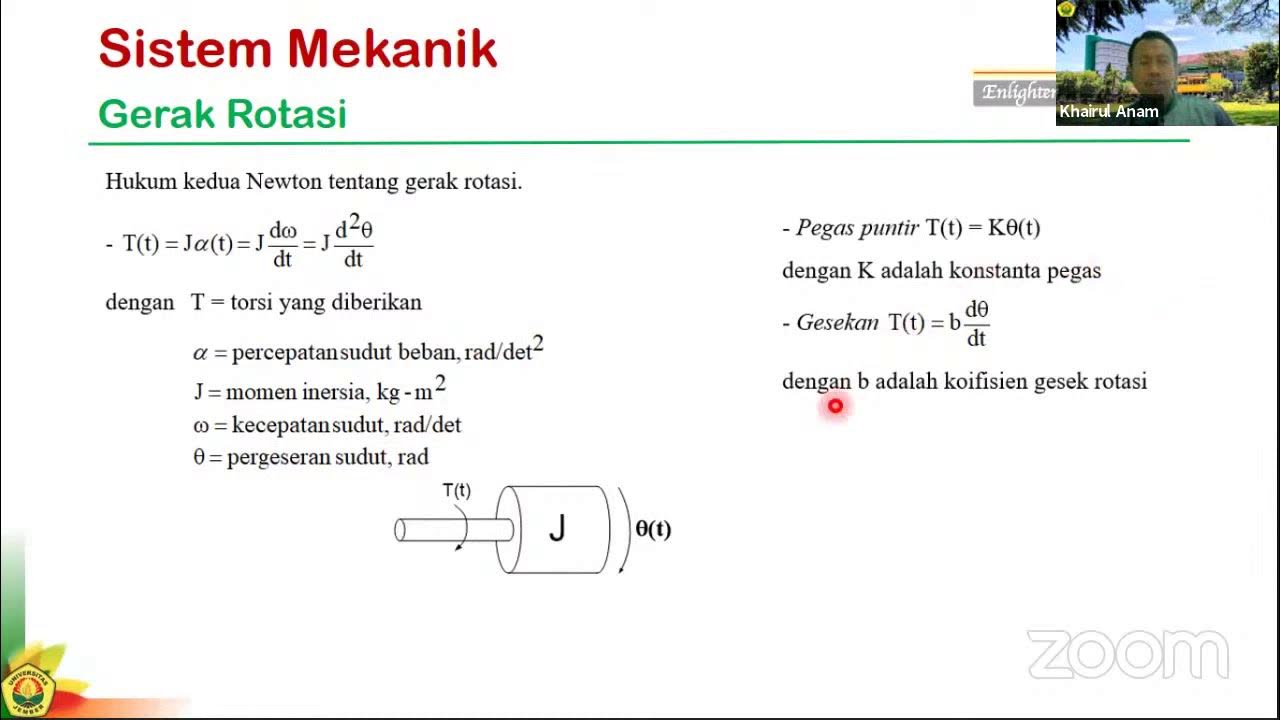Pemodelan Matematis Langkah 1 Tujuan Percobaan
Summary
TLDRThe video presents an introduction to mathematical modeling in science, focusing on linear motion. It emphasizes the importance of defining the experimental objectives, which include analyzing uniform linear motion (GLB) and uniformly accelerated linear motion (GLBB). The session outlines two main goals: to understand the principles of linear motion through experimentation and to calculate speed, velocity, and acceleration in the context of GLB and GLBB. This structured approach aims to deepen students' comprehension of motion concepts through practical analysis.
Takeaways
- 😀 The presentation starts with a warm greeting and well wishes for health and happiness.
- 😀 The focus is on understanding the steps in mathematical modeling related to physics, specifically in the topic of linear motion.
- 😀 The first step in the experimentation process is to determine the objectives of the experiment.
- 😀 Two specific objectives are identified for the experiment: analyzing uniform linear motion (GLB) and uniformly accelerated motion (GLBB).
- 😀 The first goal is to analyze GLB and GLBB in depth.
- 😀 The second goal is to calculate speed, velocity, and acceleration within the contexts of GLB and GLBB.
- 😀 The use of experiments is emphasized as a method to comprehend the subject matter more effectively.
- 😀 The script suggests that defining clear objectives is essential for the success of scientific experiments.
- 😀 Understanding the differences between uniform and non-uniform motion is crucial for students.
- 😀 The overall message encourages students to engage actively in their learning through experimentation.
Q & A
What is the main topic discussed in the transcript?
-The main topic is the steps involved in mathematical modeling in science, specifically focusing on linear motion.
What are the two primary objectives of the experiment mentioned?
-The two objectives are to analyze uniform linear motion (GLB) and uniformly accelerated linear motion (GLBB), and to calculate speed, velocity, and acceleration.
What does GLB stand for and what does it refer to?
-GLB stands for 'Gerak Lurus Beraturan,' which refers to uniform linear motion where an object moves at a constant speed in a straight line.
What is GLBB and how does it differ from GLB?
-GLBB stands for 'Gerak Lurus Berubah Beraturan,' which refers to uniformly accelerated linear motion where the speed of the object changes at a constant rate.
Why is determining the purpose of the experiment considered the first step?
-Determining the purpose of the experiment provides a clear focus and direction for the research, ensuring that the objectives are understood before conducting any experiments.
What parameters are calculated in the context of linear motion?
-The parameters calculated include speed, velocity, and acceleration, which help in analyzing the motion of the objects.
How is speed defined in the context of this experiment?
-Speed is defined as the rate at which an object covers distance, measured as distance traveled over time without regard to direction.
What is the significance of understanding acceleration in linear motion?
-Understanding acceleration is crucial as it indicates how quickly an object's velocity changes, which is important for analyzing motion dynamics.
How does one differentiate between speed and velocity?
-Speed is a scalar quantity that measures how fast an object moves, while velocity is a vector quantity that includes both speed and direction.
What role does experimentation play in the understanding of mathematical modeling?
-Experimentation allows for practical application of theoretical concepts, enabling students to observe, analyze, and understand the principles of mathematical modeling in real-world scenarios.
Outlines

This section is available to paid users only. Please upgrade to access this part.
Upgrade NowMindmap

This section is available to paid users only. Please upgrade to access this part.
Upgrade NowKeywords

This section is available to paid users only. Please upgrade to access this part.
Upgrade NowHighlights

This section is available to paid users only. Please upgrade to access this part.
Upgrade NowTranscripts

This section is available to paid users only. Please upgrade to access this part.
Upgrade NowBrowse More Related Video

SK#2c: Pemodelan Sistem dengan Persamaan Differensial

percepatan sentripetal dan tangensial

Discutindo os casos e os momentos em Modelagem Matemática

Modern Robotics, Chapter 13.2: Omnidirectional Wheeled Mobile Robots (Part 1 of 2)

Introduction of Vibration [V.2]

Gerak Benda dan Makhluk Hidup di Lingkungan Sekitar
5.0 / 5 (0 votes)